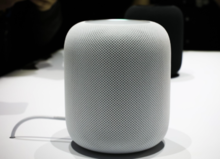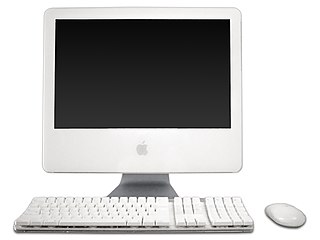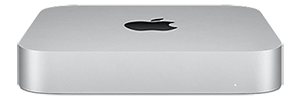Apple Inc. has produced and sold numerous music and multimedia speakers, available for standalone purchase and bundled with Macintosh products.
Apple Inc. has produced and sold numerous music and multimedia speakers, available for standalone purchase and bundled with Macintosh products.

In September 1986, Apple sold a special edition of the Bose RoomMate speakers for the Apple IIGS computer—which sports a built-in Ensoniq synthesizer chip with optional stereo sound. The front grille of each speaker had the Bose logo inside a black rectangle, and the official rainbow Apple logo in a square next to it. The speakers matched the platinum gray color scheme introduced with the IIGS that year. Later editions of the speakers, likely for legal issues pertaining to Apple Records, replaced the Apple-shaped logo with a rainbow-colored square, and eventually removed any Apple reference entirely. The powered speakers lacked a variable volume knob or magnetic shielding (a warning label stated to keep it distanced from the CRT and magnetic storage) and retailed for US$229.99(equivalent to $640 in 2023). Although primarily intended for the Apple IIGS which it cosmetically matched and better suited for its advanced audio capabilities, the speakers were also made available for early Macintosh models. [1]

Along with the PowerCD introduced in 1993, Apple released two versions of their desktop speakers: the AppleDesign Powered Speakers (M6082) and the redesigned AppleDesign Powered Speakers II (M2497) a year later. The original speakers came in platinum gray to match Apple's desktop line, while the second generation were smaller, curvier and came in both platinum gray and a darker granite gray color designed to match the PowerBook line and PowerCD. Both were powered with an AC adapter and could be attached to any audio output source, with two separate inputs for the computer and an external CD player. Both had a headphone jack in the front of one speaker along with the volume control and an optional subwoofer connection port on some models.[ citation needed ]
Apple bundled a pair of model M7963 clear spherical/globe Sound Stick 2.1 based speakers with the Power Mac G4 Cube, which was released on July 19, 2000. They used a custom USB interface and originally worked with the G4 Cube, Power PCs and ADC/ADP monitor screens. They work right up to OSX 10.6.4 Snow Leopard. They were designed by Jonathan Ive & created in partnership with Harman Kardon, and were enlarged versions of the Odyssey speakers built in to the iMac G3. [2] [3] [4]

The Apple Pro Speakers were introduced in January 2001 alongside the Power Mac G4 Digital Audio, based on the G4 Cube's spherical speakers with a new digital audio system, plastic grilles, white rubber/silicone surrounds rather than the black foam used on the G4 cube speakers and changed the connector to a proprietary minijack that provided both power and audio. They were available as a standalone purchase for $59 and bundled with some versions of the iMac G4. [3] [4]

Apple announced the iSub in 1999, a 6-inch subwoofer produced in partnership with Harman Kardon, designed by Jony Ive. [5] It uses clear plastic to match the aesthetic of the iMac G3. It connected over USB. [6]
Next, Harman Kardon and Apple designed the SoundSticks, which were introduced at the 2000 Macworld expo. [7] Apple led the industrial design and mechanical engineering to have them fit into its product family. They include a new revision of the iSub. They won an Industrial Design Excellence Awards gold award [8] and were featured on the cover of I.D. magazine. SoundSticks II were a minor upgrade, adding capacitive volume control buttons and a 3.5mm mini-jack input, replacing the previous USB input. SoundSticks III changed the styling slightly using black highlights and white lighting, instead of green and blue of the original SoundSticks and the SoundSticks II. [9] SoundSticks Wireless introduced Bluetooth. [10]

iPod Hi-Fi is a speaker system that was released on February 28, 2006, for use with any iPod digital music player. [11] The iPod Hi-Fi retailed at the Apple Store for US$349 until its discontinuation on September 5, 2007. [12] [13] The iPod Hi-Fi received criticism due to its high price, [14] lack of an AM/FM radio, [15] and the limited functionality of its remote control. [16]

The first-generation HomePod smart speaker was announced on June 5, 2017. It was sold in two colors: white and space gray. [17] It had a small touchscreen on its top, seven tweeters in its base, and a four-inch woofer towards the top, as well as six microphones used for voice control and acoustic optimization; it also supports beamforming. [17] [18] It runs the audioOS operating system, which is based on iOS. [19] The HomePod can act as a speaker and as a Siri voice assistant that listens for the "Hey Siri" command. The first-generation HomePod was discontinued on March 13, 2021. [20] The second-generation was introduced on January 18, 2023. [21]

HomePod Mini smart speaker was released on November 16, 2020. It is smaller than the HomePod, roughly spherical, and has three speakers and four microphones. [22] [23] Intercom, a new feature on HomePod and HomePod Mini introduced in iOS 14.1 and iPadOS 14.1, allows iPhone, iPad, and Apple Watch users with multiple HomePods and HomePod Minis to communicate between rooms using their voice. Siri recognizes up to six voices, and personalizes responses for each one.

The Power Macintosh, later Power Mac, is a family of personal computers designed, manufactured, and sold by Apple Computer, Inc as the core of the Macintosh brand from March 1994 until August 2006.

The Power Mac G4 Cube is a Mac personal computer sold by Apple Computer, Inc. between July 2000 and 2001. The Cube was conceived as a miniaturized but powerful computer by Apple chief executive officer (CEO) Steve Jobs and designed by Jony Ive. Apple developed new technologies and manufacturing methods for the product—a 7.7-inch (20 cm) cubic computer housed in clear acrylic glass. Apple positioned it in the middle of its product range, between the consumer iMac G3 and the professional Power Mac G4. The Cube was announced at the Macworld Expo on July 19, 2000.
Macworld/iWorld was an information technology trade show with conference tracks dedicated to Apple's Mac platform. It was held annually in the United States during January. Originally Macworld Expo and then Macworld Conference & Exposition, the gathering dates back to 1985. The conference was organized by International Data Group (IDG), co-publisher of Macworld magazine.
Apple Inc. has sold a variety of LCD and CRT computer displays since introducing their first display in 1980. Apple paused production of their own standalone displays in 2016 and partnered with LG to design displays for Macs. In June 2019, the Pro Display XDR was introduced, however it was expensive and targeted for professionals. In March 2022, the Studio Display was launched as a consumer-targeted counterpart. These are currently the only Apple-branded displays available.

The PowerBook G4 is a series of notebook computers manufactured, marketed, and sold by Apple Computer between 2001 and 2006 as part of its PowerBook line of notebooks. The PowerBook G4 runs on the RISC-based PowerPC G4 processor, designed by the AIM (Apple/IBM/Motorola) development alliance and initially produced by Motorola. It was built later by Freescale, after Motorola spun off its semiconductor business under that name in 2004. The PowerBook G4 has had two different designs: one with a titanium body with a translucent black keyboard and a 15-inch screen; and another in an aluminum body with an aluminum-colored keyboard, in 12-inch, 15-inch, and 17-inch sizes.

The Power Mac G4 is a series of personal computers designed, manufactured, and sold by Apple Computer from 1999 to 2004 as part of the Power Macintosh line. Built around the PowerPC G4 series of microprocessors, the Power Mac G4 was marketed by Apple as the first "personal supercomputers", reaching speeds of 4 to 20 gigaFLOPS. This was the first existing Macintosh product to be officially shortened as "Mac", and is the last Mac able to boot into classic Mac OS.

The iMac G5 is a series of all-in-one personal computers that was designed, manufactured and sold by Apple Computer from August 2004 to March 2006. It is the final series of iMacs to use a PowerPC processor, making it the last type of iMac that can natively run Mac OS 9 (Classic) applications.

Stevenote is a colloquial term for keynote speeches given by Steve Jobs, former CEO of Apple, at events such as the Apple Worldwide Developers Conference, Macworld Expo, and Apple Expo. Because most Apple product releases were first shown to the public at these keynotes, "Stevenotes" caused substantial swings in Apple's stock price.

The iMac G4 is an all-in-one personal computer designed, manufactured, and sold by Apple Computer from January 2002 to August 2004. The computer is comprised of a hemispheric base that holds the computer components, including the PowerPC G4 processor, attached to a flatscreen liquid-crystal display (LCD) via a stainless steel arm that allows the monitor to be easily tilted and swiveled.
Harman Kardon is a division of US-based Harman International Industries, an independent subsidiary of Samsung Electronics. Harman Kardon was originally founded in Westbury, New York, in 1953 by business partners Sidney Harman and Bernard Kardon.
A&R Cambridge Ltd (Arcam) is a British manufacturer of hi-fi equipment based in the Cambridge Innovation Park, Waterbeach, Cambridgeshire, England. It was established in 1976 by science and engineering students from the University of Cambridge. Since July 2017, it has been a part of South Korean company Samsung Electronics through its American subsidiary Harman International Industries.

Mac Mini is a small form factor desktop computer developed and marketed by Apple Inc. As of 2022, it is positioned between the consumer all-in-one iMac and the professional Mac Studio and Mac Pro as one of four current Mac desktop computers. Since launch, it has shipped without a display, keyboard, and mouse. The machine was initially branded as "BYODKM" as a strategic pitch to encourage users to switch from Windows and Linux computers.
Apple Inc. products has had various design motifs since its inception. Recent motifs were mainly developed under the collaboration of Steve Jobs and Jony Ive beginning in 1997, radically altering the previous Apple computer designs.

AirPlay is a proprietary wireless communication protocol stack/suite developed by Apple Inc. that allows the streaming of multimedia and device screens, together with related metadata, between compatible devices. Originally implemented only in Apple's own software and hardware, the company has since licensed the AirPlay protocol stack to third-party manufacturers and it has been implemented on devices such as television sets and home audio systems. AirPlay works through either a direct peer-to-peer connection between devices or through an infrastructure local network.
The following outline of Apple Inc. is a topical guide to the products, history, retail stores, corporate acquisitions, and personnel under the purview of the American multinational corporation Apple Inc.

Invoke is a smart speaker developed by Harman Kardon. It was powered by Microsoft's intelligent personal assistant, Cortana. Voice interaction with Cortana provides features such as setting alarms, facts, searches, weather, news, traffic, flights, and other real-time information. Additionally, the speaker's Cortana integration with one's Microsoft Account enabled calendars, reminders, commutes, to-do lists, and home automation features, among others.

SoundSticks are multimedia speakers sold by Harman Kardon, originally co-developed with Apple Inc. They were released in July 2000. They are a 2.1 system with a pair of satellite speakers and a subwoofer called the iSub, which was originally available first in October 1999 as a standalone product. They were designed by Jony Ive and have received numerous accolades for their industrial design. Harman Kardon released updated versions in 2004, 2009, 2012 and 2020.

The HomePod Mini is a smart speaker developed by Apple Inc. The HomePod Mini was released on November 16, 2020. Roughly a 10 cm sphere, it was released as a smaller and less expensive version of Apple's HomePod.
{{cite web}}: |last2= has generic name (help){{cite web}}: |author= has generic name (help)